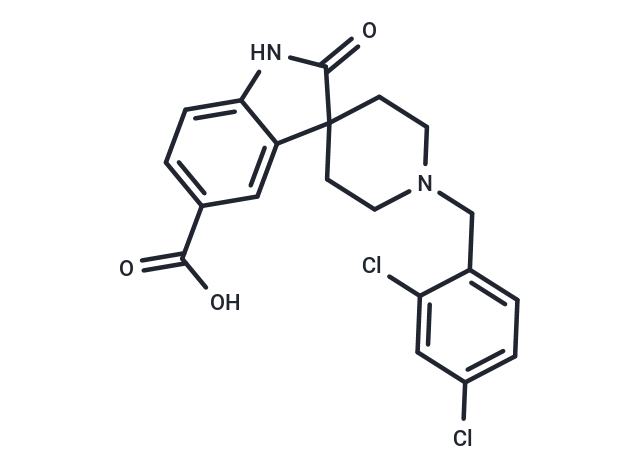 Your shopping cart is currently empty
Your shopping cart is currently empty

LI-2242 is a potent inositol hexakisphosphate kinase (IP6K) inhibitor with IC50s of 31 nM, 42 nM, 8.7 nM, and 1944 nM for IP6K1, IP6K2, IP6K3, and IPMK, respectively.LI-2242 ameliorated hepatic steatosis by reducing the expression of genes that enhance lipid uptake, lipid stabilization, and adipogenesis, and enhanced mitochondrial oxygen consumption rate (OCR) and insulin signaling in adipocytes and hepatocytes in vitro. LI-2242 ameliorated diet-induced obesity, hyperglycemia and hepatic steatosis in mice.LI-2242 can be used to study type II diabetes, obesity, metabolic complications, venous thrombosis and psychiatric disorders.

| Pack Size | Price | USA Warehouse | Global Warehouse | Quantity |
|---|---|---|---|---|
| 25 mg | $1,820 | Inquiry | Inquiry | |
| 50 mg | $2,380 | Inquiry | Inquiry | |
| 100 mg | $3,100 | Inquiry | Inquiry |
| Description | LI-2242 is a potent inositol hexakisphosphate kinase (IP6K) inhibitor with IC50s of 31 nM, 42 nM, 8.7 nM, and 1944 nM for IP6K1, IP6K2, IP6K3, and IPMK, respectively.LI-2242 ameliorated hepatic steatosis by reducing the expression of genes that enhance lipid uptake, lipid stabilization, and adipogenesis, and enhanced mitochondrial oxygen consumption rate (OCR) and insulin signaling in adipocytes and hepatocytes in vitro. LI-2242 ameliorated diet-induced obesity, hyperglycemia and hepatic steatosis in mice.LI-2242 can be used to study type II diabetes, obesity, metabolic complications, venous thrombosis and psychiatric disorders. |
| Targets&IC50 | IP6K1:31 nM, IPMK:1944 nM, IP6K2:42 nM, IP6K3:8.7 nM |
| In vitro | LI-2242 exhibits inhibitory effects on IP6K1, IP6K2, IP6K3, and IPMK with IC50 values of 31 nM, 42 nM, 8.7 nM, and 1944 nM, respectively.[1] |
| In vivo | We tested the efficacy of LI-2242 in DIO WT C57/BL6J mice. LI-2242 (20 mg/kg/BW daily, i.p.) reduced body weight in DIO mice by specifically reducing the accumulation of body fat. It also improved glycemic parameters and reduced hyperinsulinemia. LI-2242-treated mice displayed reduced the weight of various adipose tissue depots and an increased expression of metabolism- and mitochondrial-energy-oxidation-inducing genes in these tissues. LI-2242 also ameliorated hepatic steatosis by reducing the expression of genes that enhance lipid uptake, lipid stabilization, and lipogenesis. Furthermore, LI-2242 enhances the mitochondrial oxygen consumption rate (OCR) and insulin signaling in adipocytes and hepatocytes in vitro. In conclusion, the pharmacologic inhibition of the inositol pyrophosphate pathway by LI-2242 has therapeutic potential in obesity and NAFLD.[2] |
| Molecular Weight | 405.27 |
| Formula | C20H18Cl2N2O3 |
| Cas No. | 2762762-17-2 |
| Smiles | O=C(O)C1=CC=C2NC(=O)C3(C2=C1)CCN(CC4=CC=C(Cl)C=C4Cl)CC3 |
| Relative Density. | no data available |
| Storage | Powder: -20°C for 3 years | In solvent: -80°C for 1 year | Shipping with blue ice/Shipping at ambient temperature. |
| Size | Quantity | Unit Price | Amount | Operation |
|---|

Copyright © 2015-2026 TargetMol Chemicals Inc. All Rights Reserved.